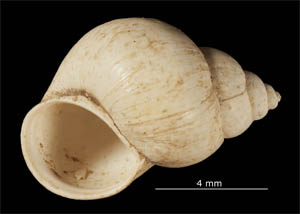Submitted by Administrator on Mon, 29/07/2013 - 15:51
A team of scientists, led by chemists from the BioArCh laboratories, University of York, and palaeontologists from the Department of Zoology, has developed a method of dating Ice Age sediments using fossil snail shells contained within them.
 The last ~2.6 million years, generally known as the 'Ice Age' or Quaternary period, has been characterized by several periods of extreme cold, during which ice-sheets covered much of northern Europe and North America. These relatively long 'glacial' episodes were punctuated by shorter 'interglacial' periods when temperatures reached or even exceeded present day values. These climatic changes are recorded in greatest detail in deep sea sediments and ice-cores from polar regions. The records from the land, which are most accessible to geologists and archaeologists, are far less complete and are difficult to link to these continuous records of global climatic change. In addition, most terrestrial sediments are too old to date directly using familiar methods such as radiocarbon dating.
The last ~2.6 million years, generally known as the 'Ice Age' or Quaternary period, has been characterized by several periods of extreme cold, during which ice-sheets covered much of northern Europe and North America. These relatively long 'glacial' episodes were punctuated by shorter 'interglacial' periods when temperatures reached or even exceeded present day values. These climatic changes are recorded in greatest detail in deep sea sediments and ice-cores from polar regions. The records from the land, which are most accessible to geologists and archaeologists, are far less complete and are difficult to link to these continuous records of global climatic change. In addition, most terrestrial sediments are too old to date directly using familiar methods such as radiocarbon dating.
A team of scientists, led by chemists from the BioArCh laboratories, University of York, and palaeontologists from the Department of Zoology, has developed a method of dating Ice Age sediments using fossil snail shells contained within them. The team has conducted the most comprehensive dating of the British Quaternary yet undertaken using a single method, providing analyses of 470 fossils from 71 sites. The method, known as amino acid racemization, measures the extent of protein degradation within calcareous fossils, such as mollusc shells. The technique, which was pioneered about 40 years ago, is now significantly more accurate thanks to the discovery that amino acids (the building blocks of protein) are best preserved in the opercula of certain snails. Opercula are tiny lids that close the mouths of certain species of snail when they withdraw into their shells. They are composed of a different form of lime that provides a more stable 'closed system' repository for amino acids, enabling higher resolution dating of archaeological and geological sites.
The research, published in the latest issue of Nature, details the technique developed by Dr Kirsty Penkman and Professor Matthew Collins, University of York, using fossil material largely provided by Dr Richard Preece, in the Department.
Dr Penkman said that "The amino acids preserved within calcium carbonate crystals of the opercula are essentially a protein time capsule, which provide a chronology for events within the Ice Age". The results have shed light on the timing of early human presence in Britain, establishing occupation as least ~700,000 years ago. Moreover, no archaeological site in Britain can be attributed to the Last Interglacial (~125,000 years ago), suggesting that humans were absent during that warm period. Professor Collins said "When we started this work 11 years ago, we thought it was going to be relatively straightforward to identify a good material for dating, but the first 3 years of research on shells showed that the stability of the mineral itself was vital. The tiny trapdoor of a snail proved to be the key to success."
Richard Preece said that "Fossil opercula are common in Quaternary sediments around the world, so the new technique can be used to build regional Ice Age chronologies everywhere, giving it enormous international scope". Quaternary scientists from the Universities of Durham and Birmingham and the Naturalis Museum, Leiden and The Natural History Museum, London, also contributed to the research. The analyses were funded by English Heritage, the Natural Environment Research Council (NERC) and the Wellcome Trust. The research is a contribution to the Ancient Human Occupation of Britain (AHOB) project funded by the Leverhulme Trust.
http://www.nature.com/nature/journal/vaop/ncurrent/full/nature10305.html
